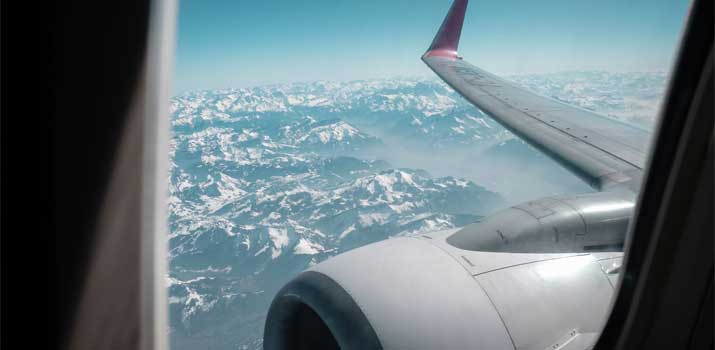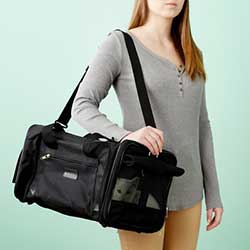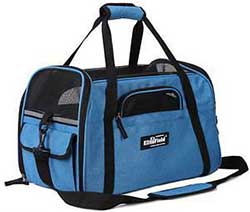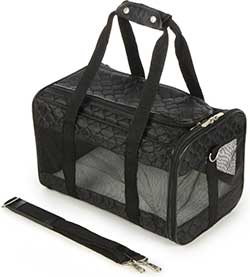For many dog owners, taking their canine companions on a fun vacation is like a dream come true. There's nothing better than experiencing new sites and sounds with your best friend in tow.
These days, taking a road trip (which is the most popular choice for long-distance dog trips) is pretty easy with all of the pet-friendly accommodations out there. However, air travel is a different story.
Airplanes are notoriously strict with what and who comes onboard.
Many allow dogs to travel on in the cargo hold. But what about traveling in the cabin?

Can You Buy a Seat for Your Dog on an Airplane?
Many airlines allow you to bring dogs into the cabin. However, only a couple will let you buy a seat for your dog. Most require you to store your dog in a carrier under the seat in front of you.
The two exceptions are Jet Blue and United.
These airlines give you the option to purchase an additional seat. However, whether or not you're able to do this depends on availability. Only a small number of pets are allowed on any single flight.
In most cases, it's four. If there are already reservations for canine in-cabin travel, you may have no choice but to send your dog to cargo or book another flight.
Furthermore, airlines typically have different rules for domestic and international flights. Domestic routes tend to be more accepting of dogs than international ones.
Airlines That Allow Dogs in Cabin
Jet Blue and Delta are the most popular for dog owners, but they're not the only airlines available.
Alaska Airlines, American Airlines, and Southwest Airlines also have pet policies.
Fees and policies for shipping your dog vary from one airline to the next, so make sure to do some research before booking a flight. Many require you to make special reservations well in advance if you plan on bringing your dog with you.
How Much Does Canine Air Travel Cost?
All airlines will charge additional fees per pet. Not only that, but you may see different charges based on the flight schedule.
Generally, the service fee for bringing your dog into the cabin is between $95.00 and $125. Those costs apply to each dog accompanying you.
If you are taking a flight with layovers, be prepared to pay more. United Airlines, for example, charges an additional $125 for layovers that last more than four hours.
Similar charges exist for other airlines, too.
On top of all those added fees, you have to pay for the seat itself. You don't get a discount of any kind on the seat for your dog. It'll have the same market price as any of the other seats. In fact, you might have to pay more.
That's because some airlines require you to book that additional seat directly through them. That means no savings through third-party booking sites!
Airplane Rules and Restrictions
Now that you have a better idea of which airlines to work with, let's talk about some restrictions and rules.
You can't just walk onto a plane with your dog and expect things to go smoothly. There's a lot of preparation involved!
The airline industry is one of the most strict and heavily regulated industries around. To avoid any mishaps and delays, make sure to read up on all pet policies. It'll save you a lot of headaches at the gate.
Here are some of the most common rules that exist across all airlines.
Breeds
As dog lovers, breed restrictions seem a little archaic and misinformed. But, they exist nonetheless.
All of the usual "aggressive breeds" are strictly prohibited by most airlines. The most common dog on that list is the Pit Bull and any of its variants.
You might also see German Shepherds, Rottweilers, Bulldogs, and more on that list.
Several airlines also prohibit breeds with known medical issues. Thanks to some high-profile deaths in recent years, brachycephalic breeds are a no-go.
Brachycephalic breeds include Pugs, Bulldogs, Pekingese, and more. These dogs are known to have difficulties breathing.
There have been so many problems with these dogs that most airlines don't even allow them in the cargo hold!
Size and Weight
Even if you buy a dedicated seat for your dog, airlines have strict weight and size requirements. These restrictions ensure that the dog can fit under seats and in tight spots.
Generally, the combined weight of the dog and its carrier cannot exceed 20 pounds.
There are some exceptions, which we'll get into later. Unfortunately, larger dogs aren't allowed in the cabin. They'll have to travel in the cargo hold.
Related: Best Dog Carrier Backpacks for Hiking this year
Classification
In this context, a dog's classification refers to its role. Is your dog a pet? What about a service animal or emotional support animal? Those distinctions matter.
Service dogs are protected by federal law. According to the Americans with Disabilities Act, service dogs are permitted to fly with their owners. They must be allowed to sit with owners in the cabin.
There are special rules and regulations for service dogs, but airlines cannot stop you from traveling with them. Just be prepared to provide any requested documentation.
Service animals are trained to perform specific tasks. Therefore, airlines tend to have very few problems with them.
Emotional support animals, also known as ESAs, are a bit different. An ESA dog doesn't have training as a service dog. As a result, the laws surrounding legal entitlement are different.
You have to have a Prescription from a mental health professional to travel with an ESA in most cases. If you have that, airlines will permit your dog to travel inside the cabin with you.
The laws surrounding service dogs and ESAs are complex. We recommend reading up on airline policies and requirements.
Behavior
One of the most important things to consider is your dog's behavior. Canines have to be quiet and well-behaved on a flight. Otherwise, there will be a mountain of trouble!
Dogs that are barking or aggressive aren't permitted on flights. Airlines can use their discretion here. They can move your dog to cargo or refuse to transport them altogether.
Documentation and Health Requirements
In addition to all of the rules and regulations, you have to have some written documentation. Dogs flying in the cabin must undergo some significant health checks to ensure that they're ready to fly.
The exact documents will vary based on the airline.
However, the essential documents usually include vaccination certificates, health certificates, and health screening results.
All of these documents are available from the airline. To get them filled out, visit your vet!
Your vet will perform the necessary tests to meet all of the requirements. Health screenings usually include rabies titer tests, parasite screenings, and more.
Of course, vaccinations for rabies, kennel cough, and more are a must.
Some airlines also require your dog to have a microchip just in case you get separated.
Once again, read all of your airline's requirements! Don't put the documentation off. The sooner you get it done, the easier your travel endeavors will be.
Do Dogs Have to Stay in a carrier?
Unless you have a service or ESA, all dogs must stay in a carrier. The carrier serves a couple of different purposes. First, it keeps your dog contained to ensure that they don't disturb other fliers.
Secondly, it keeps them safe in the event of an emergency.
Airlines have their own size requirements. Typically, they reflect the amount of room you have under the seat in front of you.
For Jet Blue, all pet carriers must be no bigger than 17 inches long, 12.5 inches wide, and 8.5 inches tall.
United Airlines has size requirements for hard-shell and soft carriers. Soft carriers can be 18 inches long, 11 inches wide, and 11 inches tall.
Meanwhile, hard-shell units can be as big as 17.5 inches long, 12 inches wide, and 7.5 inches tall.
Don't make the mistake of trying to fit a larger dog in a small carrier. Not only is doing so unsafe and uncomfortable for your dog, but airlines often check to ensure that your dog can move around comfortably.
Your pup should have the ability to stand up, lay down, and turn around while inside the carrier.
Airline-Approved Pet Carriers
It's vital to purchase an airline-approved dog carrier well in advance to prepare for your flight. Luckily, there are many options out there. Here are some of the best products that fit the bill for most airlines.
Sherpa Delta Airline-Approved Dog & Cat Carrier Bag

This soft-sided carrier from Sherpa is specifically designed to meet the requirements of Delta and some of its partner airlines. The carrier looks like your average carry-on duffel-style luggage bag. However, it has enough room to fit dogs up to 16 pounds.
Large mesh windows provide plenty of ventilation. Meanwhile, padding and a faux lambskin lining keep your dog comfortable.
The top features a unique spring wireframe. When it's time to take off, the frame will compress slightly to conform to under-seat dimensions.
While in transit through the airport, you can use the included shoulder strap to carry your dog through security.

Available in a slew of colors, the EliteField carrier is one that you can always identify and keep an eye on. It's soft-sided and available in two sizes.
A mesh top and multiple windows provide all the ventilation your dog needs. Not only that, but the windows let light comfort a nervous dog. Inside, there's a plush bed that you can easily remove for washing.
Despite being soft-sided, the carrier is well-made. It holds its structure well whether you put it on the floor or in the seat next to you. For additional safety, the carrier even has loops for a seat belt.

Another choice from Sherpa, this carrier is compact enough to fit most standard airline restrictions. It's available in two sizes.
Like the previous Sherpa model, this one has a spring frame. Tuck it under the seat and let the top compress for a snug and safe fit.
This carrier is perfect for dogs that don't like being left in the dark. There are numerous mesh windows on all sides to keep them comfortable.
Durable hand straps and a removable shoulder strap make it easy to carry.
Conclusion
Flying with your dog can be a stressful and confusing situation. If you want to buy a seat for your dog on an airplane, you must follow tons of rules and regulations.
Despite all that, the experience can be pretty rewarding. Take some time to familiarize yourself with an airline's requirements. Prepare for your travels and invest in all the equipment your dog needs. If you do things right, it'll be smooth sailing and safe travels to your destination.

